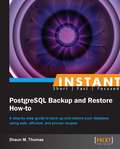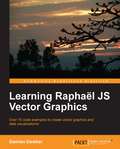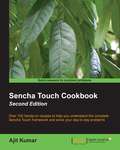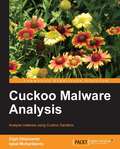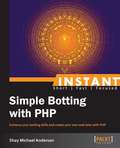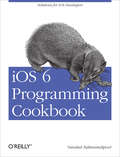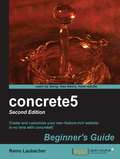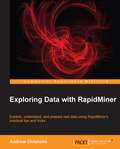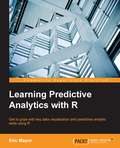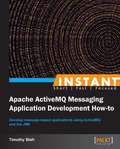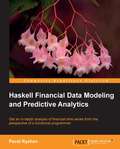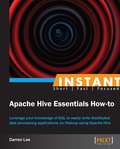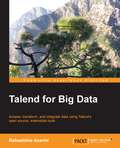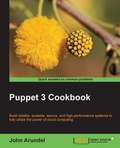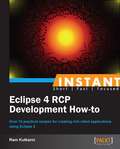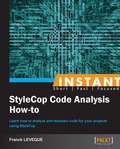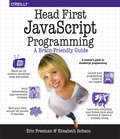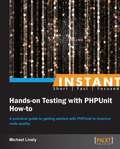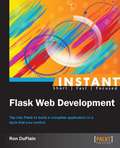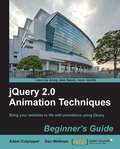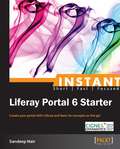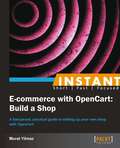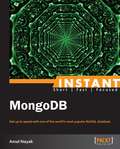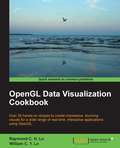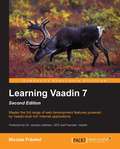- Table View
- List View
Instant PostgreSQL Backup and Restore How-to
by Shaun M. ThomasFilled with practical, step-by-step instructions and clear explanations for the most important and useful tasks. This hands-on guide provides a quick and easy way to back up and restore your database using PostgreSQL.Written for database administrators who want to create backups of their critical enterprise data and efficiently restore it using PostgreSQL.
Learning Raphaël JS Vector Graphics
by Damian DawberA step-by-step guide to understanding the principles underlying vector drawing, using illustrations and code demos along with interactive maps to fully exploit the JavaScript library to create a data visualization widget.Learning Raphaël JS Vector Graphics has been written for anyone with an interest in frontend browser technologies with little or no knowledge of vector graphics drawing. Designers, integrators, frontend developers, and data visualization developers will get something out of reading this book. The book assumes knowledge of HTML and CSS and a working familiarity with JavaScript.
Sencha Touch Cookbook, Second Edition
by Ajit KumarThe book is written in a Cookbook style, presenting examples in the style of recipes, allowing you to go directly to your topic of interest or follow topics throughout a chapter to gain in-depth knowledge.Sencha Touch Cookbook (2nd edition) is great for developers who are new to Sencha Touch and who are looking to get a good hold on what the Sencha Touch framework offers and how to use it to build a great touch-based mobile application running on different platforms. It is assumed that you will have some experience in HTML, CSS, DOM, and JavaScript. To truly appreciate the framework capability and take full advantage of the book, readers are expected to have one or more mobile devices.
Cuckoo Malware Analysis
by Iqbal Muhardianto Digit OktaviantoThis book is a step-by-step, practical tutorial for analyzing and detecting malware and performing digital investigations. This book features clear and concise guidance in an easily accessible format.Cuckoo Malware Analysis is great for anyone who wants to analyze malware through programming, networking, disassembling, forensics, and virtualization. Whether you are new to malware analysis or have some experience, this book will help you get started with Cuckoo Sandbox so you can start analysing malware effectively and efficiently.
Instant Simple Botting with PHP
by Shay Michael Andersondo for you, and then get to work with the most important features and tasks. This book is a hands-on Starter guide that takes the reader from initialization to the coding and implementation of bot apps.Instant Simple Botting with PHP targets programmers of all levels who are familiar with common PHP functions and syntax, and who want to learn about bots and how to design and develop bots using objects.
iOS 6 Programming Cookbook: Solutions for iOS Developers
by Vandad NahavandipoorOvercome the vexing issues you’ll inevitably confront when creating apps for the iPhone, iPad, or iPod touch. By making use of new and revised recipes in this updated cookbook, you’ll quickly learn the steps necessary to write complete iOS apps—including ways to store and protect data, enhance and animate graphics, manage files and folders, and take advantage of Passbook.Thoroughly updated for iOS 6 SDK, this cookbook shows you how to use hundreds of techniques to solve problems that developers of all levels commonly face. Each recipe includes sample code you can use right away.Use Pass Kit to deliver digitally-signed passes such as loyalty cardsDefine the layout of UI elements with Cocoa Auto LayoutDevelop location-aware appsGet working examples for implementing gesture recognizersUse new Objective-C Runtime featuresPlay audio and video files and access the iPod libraryRetrieve contacts and groups from the Address BookDetermine camera availability and access the Photo LibraryCreate multitasking-aware appsUse Event Kit to manage calendars, dates, and eventsApply the accelerometer and gyroscopeEnhance your app with the iCloud service
concrete5 Beginner's Guide Second Edition
by Remo LaubacherThis is a beginner's guide, which takes a clear, step-by-step approach to guide you through the process of creating and adding functionality to your site.This book is ideal for developers experienced with HTML and CSS and possibly PHP as well as JavaScript, who would like to build their first site with Concrete5. Some knowledge of PHP, MySQL, or HTML would be useful, but no experience with Concrete5 is expected.
Exploring Data with RapidMiner
by Andrew ChisholmA step-by-step tutorial style using examples so that users of different levels will benefit from the facilities offered by RapidMiner.If you are a computer scientist or an engineer who has real data from which you want to extract value, this book is ideal for you. You will need to have at least a basic awareness of data mining techniques and some exposure to RapidMiner.
Learning Predictive Analytics with R
by Eric MayorGet to grips with key data visualization and predictive analytic skills using R About This Book * Acquire predictive analytic skills using various tools of R * Make predictions about future events by discovering valuable information from data using R * Comprehensible guidelines that focus on predictive model design with real-world data Who This Book Is For If you are a statistician, chief information officer, data scientist, ML engineer, ML practitioner, quantitative analyst, and student of machine learning, this is the book for you. You should have basic knowledge of the use of R. Readers without previous experience of programming in R will also be able to use the tools in the book. What You Will Learn * Customize R by installing and loading new packages * Explore the structure of data using clustering algorithms * Turn unstructured text into ordered data, and acquire knowledge from the data * Classify your observations using Naïve Bayes, k-NN, and decision trees * Reduce the dimensionality of your data using principal component analysis * Discover association rules using Apriori * Understand how statistical distributions can help retrieve information from data using correlations, linear regression, and multilevel regression * Use PMML to deploy the models generated in R In Detail R is statistical software that is used for data analysis. There are two main types of learning from data: unsupervised learning, where the structure of data is extracted automatically; and supervised learning, where a labeled part of the data is used to learn the relationship or scores in a target attribute. As important information is often hidden in a lot of data, R helps to extract that information with its many standard and cutting-edge statistical functions. This book is packed with easy-to-follow guidelines that explain the workings of the many key data mining tools of R, which are used to discover knowledge from your data. You will learn how to perform key predictive analytics tasks using R, such as train and test predictive models for classification and regression tasks, score new data sets and so on. All chapters will guide you in acquiring the skills in a practical way. Most chapters also include a theoretical introduction that will sharpen your understanding of the subject matter and invite you to go further. The book familiarizes you with the most common data mining tools of R, such as k-means, hierarchical regression, linear regression, association rules, principal component analysis, multilevel modeling, k-NN, Naïve Bayes, decision trees, and text mining. It also provides a description of visualization techniques using the basic visualization tools of R as well as lattice for visualizing patterns in data organized in groups. This book is invaluable for anyone fascinated by the data mining opportunities offered by GNU R and its packages. Style and approach This is a practical book, which analyzes compelling data about life, health, and death with the help of tutorials. It offers you a useful way of interpreting the data that's specific to this book, but that can also be applied to any other data.
Instant Apache ActiveMQ Messaging Application Development How-to
by Timothy BishFilled with practical, step-by-step instructions and clear explanations for the most important and useful tasks.This is a Packt Instant How-to guide, which provides concise and practical recipes to help you get started writing applications with ActiveMQ using practical examples.Instant ActiveMQ Application Development How-to is for the developers who are new to Java Message Service application development or new to JMS development using ActiveMQ. Readers will come away ready to solve complicated messaging related problems using the JMS API and ActiveMQ.
Haskell Financial Data Modeling and Predictive Analytics
by Pavel RyzhovThis book is a hands-on guide that teaches readers how to use Haskell's tools and libraries to analyze data from real-world sources in an easy-to-understand manner.This book is great for developers who are new to financial data modeling using Haskell. A basic knowledge of functional programming is not required but will be useful. An interest in high frequency finance is essential.
Instant Apache Hive Essentials How-to
by Darren LeeFilled with practical, step-by-step instructions and clear explanations for the most important and useful tasks.This book provides quick recipes for using Hive to read data in various formats, efficiently querying this data, and extending Hive with any custom functions you may need to insert your own logic into the data pipeline.This book is written for data analysts and developers who want to use their current knowledge of SQL to be more productive with Hadoop. It assumes that readers are comfortable writing SQL queries and are familiar with Hadoop at the level of the classic WordCount example.
Talend for Big Data
by Bahaaldine AzarmiThis book is written in a concise and easy-to-understand manner, and acts as a comprehensive guide on data analytics and integration with Talend big data processing jobs. If you are a chief information officer, enterprise architect, data architect, data scientist, software developer, software engineer, or a data analyst who is familiar with data processing projects and who wants to use Talend to get your first big data job executed in a reliable, quick, and graphical way, then Talend for Big Data is perfect for you.
Puppet 3 Cookbook
by John ArundelPuppet 3 Cookbook is written in a Cookbook style, showing you how to set up and expand your Puppet infrastructure. It not only gives you everything you need to become a Puppet expert, but includes powerful code samples and techniques developed over many years of production experience. With it, you'll save time and effort by automating tedious manual processes, impress your boss by delivering better business value from IT, and future-proof your career by getting to grips with the new technologies revolutionizing the industry."Puppet 3 Cookbook" is for anyone who builds and administers servers, especially in a web operations context. It requires some experience of Linux systems administration, including familiarity with the command line, file system, and text editing. No programming experience is required.
Instant Eclipse 4 RCP Development How-to
by Ram KulkarniFilled with practical, step-by-step instructions and clear explanations for the most important and useful tasks.A concise guide that delivers immediate results with practical recipes on learning practical hints and avoiding pitfalls in Eclipse 4 development.You will find this book useful if you are looking to create cross-platform rich client applications. Eclipse platform is built with Java, so basic knowledge of Java is essential. The focus of this book is to understand the new APIs and concepts of the Eclipse 4 platform. Prior knowledge of basic concepts of the Eclipse framework (plugin, extension, perspective, workspace, and so on), SWT (Standard Widget Toolkit), and JFace would be beneficial in understanding the examples in this book quicker.
Instant StyleCop Code Analysis How-to
by Franck LevequeFilled with practical, step-by-step instructions and clear explanations for the most important and useful tasks.The book will take a how-to approach, focusing on recipes that demonstrate Stylecop code analysis.Stylecop Code Analysis How-to is intended for developers and project managers who are looking for an all-encompassing overview of Stylecop to display or enforce their specific coding conventions. It is assumed that you have a minimal understanding of integration technologies such as MSBuild and Nant. You should also have some knowledge on how to program in C# and LINQ. An available version of Visual Studio 2008 professional or superior is also required to follow the first chapters of this book.
Head First JavaScript Programming
by Elisabeth Robson Eric T. FreemanWhat will you learn from this book? This brain-friendly guide teaches you everything from JavaScript language fundamentals to advanced topics, including objects, functions, and the browser's document object model. You won't just be reading--you'll be playing games, solving puzzles, pondering mysteries, and interacting with JavaScript in ways you never imagined. And you'll write real code, lots of it, so you can start building your own web applications. Prepare to open your mind as you learn (and nail) key topics including:<P> The inner details of JavaScript<P> How JavaScript works with the browser<P> The secrets of JavaScript types<P> Using arrays<P> The power of functions<P> How to work with objects<P> Making use of prototypes<P> Understanding closures<P> Writing and testing applications<P> What's so special about this book?<P> We think your time is too valuable to waste struggling with new concepts. Using the latest research in cognitive science and learning theory to craft a multi-sensory learning experience, Head First JavaScript Programming uses a visually rich format designed for the way your brain works, not a text-heavy approach that puts you to sleep.<p> Advisory: Bookshare has learned that this book offers only partial accessibility. We have kept it in the collection because it is useful for some of our members. To explore further access options with us, please contact us through the Book Quality link on the right sidebar. Benetech is actively working on projects to improve accessibility issues such as these.
Instant Hands-on Testing with PHPUnit How-to
by Michael LivelyFilled with practical, step-by-step instructions and clear explanations for the most important and useful tasks. This is a Packt Instant How-to guide, which provides concise and clear recipes for getting started with PHPUnit for performing code testing and improving code quality."Instant Hands-on Testing with PHPUnit How-to" is for PHP developers that have an appreciation for writing accurate code. If you are new to PHPUnit, it will give you a solid foundation for understanding how to use PHPUnit to write tests for your projects. If you already have a cursory understanding of PHPUnit it will whet your appetite for some of the more difficult-to-understand concepts in PHPUnit.
Instant Flask Web Development
by Ron DuplainFilled with practical, step-by-step instructions and clear explanations for the most important and useful tasks. The book uses a bottom-up approach to help you build applications, and is full of step-by-step instructions and practical examples to help you improve your knowledge.Instant Flask Web Development is for developers who are new to web programming, or are familiar with web programming but new to Flask. This book gives you a head start if you have some beginner experience with Python and HTML, or are willing to learn.
jQuery 2.0 Animation Techniques Beginner's Guide
by Dan Wellman Adam CulpepperThis book is a guide to help you create attractive web page animations using jQuery. Written in a friendly and engaging approach this book is designed to be placed alongside your computer as a mentor.If you are a web designer or a frontend developer or if you want to learn how to animate the user interface of your web applications with jQuery, this book is for you. Experience with jQuery or Javascript would be helpful but solid knowledge base of HTML and CSS is assumed.
Instant Liferay Portal 6 Starter
by Sandeep NairGet to grips with a new technology, understand what it is and what it can do for you, and then get to work with the most important features and tasks. A simple Starter approach towards understanding significant areas of portals such as content management, document management, and collaboration. It also provides an overview of Liferay concepts and terminologies.Instant Liferay Portal 6 Starter is great for new users who want to know what Liferay is all about. It will quickly give them an overview about Liferay Portal and its features. It is also good for those who want to analyze whether Liferay is fit for their requirements and are interested in what unique features Liferay can offer.
Instant E-commerce with OpenCart: Build a Shop How-to
by Murat YilmazFilled with practical, step-by-step instructions and clear explanations for the most important and useful tasks. "Instant E-Commerce with OpenCart: Build a Shop How-to" is written in a friendly, helpful style which takes you through several distinct recipes, all geared to getting you started with OpenCart and selling your products as quickly and as efficiently as possible. The only thing you need to bring to the table is a desire to sell your products online."Instant E-Commerce with OpenCart: Build a Shop How-to" is for anyone who wants to learn how to quickly set up, configure, and manage an online shop with OpenCart. Regardless of whether you are technically skilled or not, this book will show you how to create a fully functioning e-commerce solution.
Instant MongoDB
by Amol NayakGet to grips with a new technology, understand what it is and what it can do for you, and then get to work with the most important features and tasks. MongoDB Starter is a fast and practical guide designed to help you start developing high-performance and scalable applications using MongoDB.MongoDB Starter is ideal for developers who are new to MongoDB and who need a no-nonsense guide on how to start working with it. No knowledge of MongoDB is required to follow this book, but some knowledge of C++ would be helpful.
OpenGL Data Visualization Cookbook
by Raymond C. H. Lo William C. Y. LoOver 40 hands-on recipes to create impressive, stunning visuals for a wide range of real-time, interactive applications using OpenGL About This Book * Get acquainted with a set of fundamental OpenGL primitives and concepts that enable users to create stunning visuals of arbitrarily complex 2D and 3D datasets for many common applications * Explore interactive, real-time visualization of large 2D and 3D datasets or models, including the use of more advanced techniques such as stereoscopic 3D rendering. * Create stunning visuals on the latest platforms including mobile phones and state-of-the-art wearable computing devices Who This Book Is For This book is aimed at anyone interested in creating impressive data visualization tools using modern graphics hardware. Whether you are a developer, engineer, or scientist, if you are interested in exploring the power of OpenGL for data visualization, this book is for you. While familiarity with C/C++ is recommended, no previous experience with OpenGL is assumed. What You Will Learn * Install, compile, and integrate the OpenGL pipeline into your own project * Create interactive applications using GLFW and handle user inputs with callback functions * Use OpenGL primitives and features in the OpenGL Shading Language (GLSL) * Render complex 3D volumetric data with techniques such as data slicers and multiple viewpoint projection * Implement a hardware-accelerated data visualizer, heat map generator, point cloud rendering, perspective rendering, and alpha blending * Process images or video sources with texture mapping and custom fragment shader programs for image resizing and wrapping * Develop video see-through augmented reality applications with OpenGL * Visualize 3D models using meshes and surfaces with dynamic lighting In Detail OpenGL is a great multi-platform, cross-language, and hardware-accelerated graphics interface for visualizing large 2D and 3D datasets. Data visualization has become increasingly challenging using conventional approaches as datasets become larger and larger, especially with the Big Data evolution. From a mobile device to a sophisticated high-performance computing cluster, OpenGL libraries provide developers with an easy-to-use interface to create stunning visuals in 3D in real time for a wide range of interactive applications. This book provides easy-to-follow, hands-on tutorials to create appealing OpenGL-based visualization tools with minimal development time. We will first illustrate how to quickly set up the development environment in Windows, Mac, and Linux. Next, we will demonstrate how to visualize data for a wide range of applications using OpenGL, starting from simple 2D datasets to increasingly complex 3D datasets with more advanced techniques. Each chapter addresses different visualization problems encountered in real life and introduces the relevant OpenGL features and libraries in a modular fashion. By the end of this book, you will be equipped with the essential skills to develop a wide range of impressive OpenGL-based applications for your unique data visualization needs, on platforms ranging from conventional computers to the latest mobile/wearable devices. Style and approach This is an easy-to-follow, comprehensive Cookbook showing readers how to create an application with real-time, interactive data visualization in stereoscopic 3D. Each topic is explained in a step-by-step format. A range of hot topics is included, including data visualization on mobile and wearable platforms."
Learning Vaadin 7: Second Edition
by Nicolas FrankelThis book begins with a tutorial on Vaadin 7, followed by a process of planning, analyzing, building, and deploying a fully functional RIA while covering troubleshooting details along the way, making it an invaluable resource for answers to all your Vaadin questions.If you are a Java developer with some experience in development either on JSP/Servlet or on Swing, and want to enter the world of rich Internet applications, then this technology and book is ideal for you. Learning Vaadin will be perfect as your next step towards building eye-catching, dynamic web applications on a Java-based platform.
